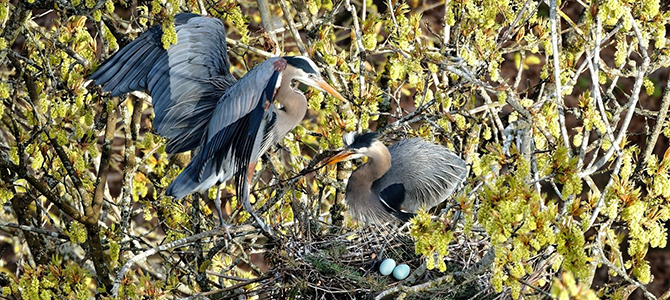
 Stanley Park herons return to raise next generation
Stanley Park herons return to raise next generation
Springtime in Vancouver brings longer days, the bright burst of daffodils and the prehistoric screech of wings in the trees above Stanley Park, which can only mean one thing: the iconic great blue heron colony has officially returned to nest.
High above Park Lane, surrounding the tennis courts, the 64-strong heron colony has settled into its home for the 23rd consecutive year to raise the next generation.
Last year the colony brought approximately 90 new heron chicks into the world, overcoming persistent eagle raids and a late nesting season, due to more severe winter weather.
Throughout these challenges, this heron colony has proven to be above all else, resilient. With 80 per cent of British Columbia’s great blue heron population found in and around the Fraser River, the productivity of this heronry has signification implications for the viability of the whole subspecies.
Heron Cam
Now in its eighth year, the Heron Cam provides the ultimate close-up view of this remarkable species as they go about their daily rituals, including courtship, and mating, nest building, egg laying, and of course, hatching! Viewers can access a birds-eye view of the 40 nests and even take control of the camera by zooming in on multiple nests, using different angles.
Witness the chicks take their first tentative steps by viewing the Stanley Park Heron Cam at vancouver.ca/heron-cam
Heron coexistence
To ensure herons are given space to nest and raise their young peacefully, between mid-March to mid-July, visitors should:
- Observe herons from outside of fenced areas
- Avoid making loud noises or playing amplified music within 30m of the colony
- Keep dogs on-leash
- Refrain from flying drones. Drones are not allowed in parks without a permit, and should strictly not be flown around nesting birds
Report a fallen or injured chick via the Van311 app or by calling 3-1-1. Please do not handle any injured wildlife.
About Pacific Great Blue Herons
Pacific Great Blue Herons were first documented in Stanley Park in 1921. Since then, the colony has changed nesting locations several times before settling in its current location in 2001. Vancouver is proudly one of North America’s largest urban heron colonies.
Pacific Great Blue Herons are federally protected and classified as of 'special concern' in British Columbia. The population of these herons has declined steadily since the 1980s as a result of nesting failure, eagle attacks, human disturbance, and habitat loss. In Canada, there are around 4-5,000 nesting adults, with the majority living around the Salish Sea. Pacific Great Blue Herons are also unique in that they do not migrate as most great blue herons do.
Find out more about the history of the Pacific Great Blue Herons at Stanley Park
Heron monitoring
Working in conjunction with the Vancouver Board of Parks and Recreation and the Canadian Wildlife Service, the Stanley Park Ecology Society (SPES) has been supporting herons in this urban environment and monitoring the heronry in Stanley Park since 2004.
Learn more about herons, how you can support, and keep up to date on heron-focused events this season at: stanleyparkecology.ca/ecology/great-blue-herons External website, opens in new tab